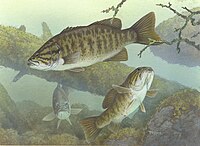
Photo from wikipedia
Geometric morphology can be influenced by several biotic and abiotic factors, including predator–prey interactions and habitat structure. We measured the external morphology of Micropterus salmoides (largemouth bass, LMB) from two… Click to show full abstract
Geometric morphology can be influenced by several biotic and abiotic factors, including predator–prey interactions and habitat structure. We measured the external morphology of Micropterus salmoides (largemouth bass, LMB) from two states in north-eastern United States, to assess the potential divergence of body shape. LMB varied in overall body shape (canonical variate analysis, P<0.001) between states, with Maine populations exhibiting shorter jaws (ANOVA, P<0.001) and thicker caudal peduncle depths (ANOVA, P<0.001) than the LMB in Pennsylvania. We propose that these observed differences in morphological traits suggest that jaw length may be influenced by prey availability and resource utilisation, whereas peduncle depth is better explained by surrounding habitat structure. These findings showed that body shape is variable and is influenced by a complex array of environmental factors, even over small latitudinal differences.
Journal Title: Marine and Freshwater Research
Year Published: 2018
Link to full text (if available)
Share on Social Media: Sign Up to like & get
recommendations!